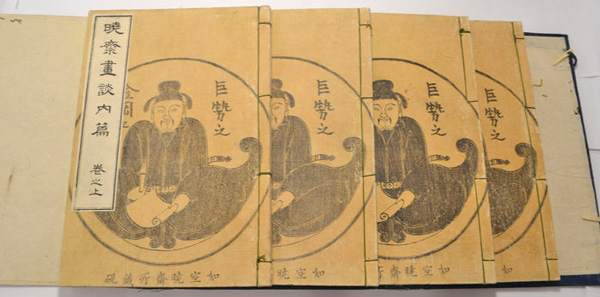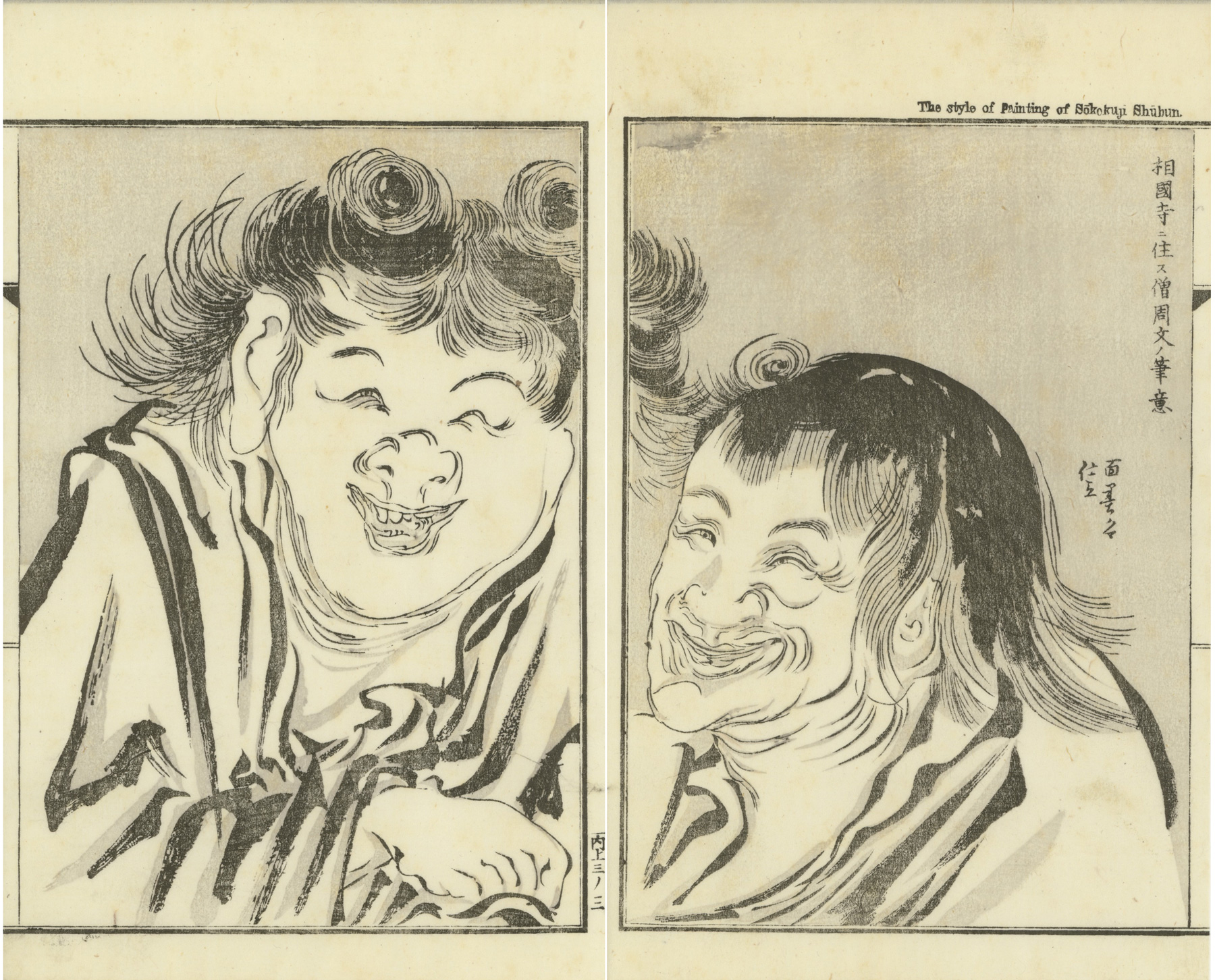About this Print and the Book
A double-bookplate removed from the first volume of Kawanabe Kyosai's four volume work Kyōsai Gadan 暁斎画談, variously translated as "Kyōsai's Account of Painting," "Kyōsai's Treatise on Painting," and "Stories of Painting by Kyōsai."

The four volumes comprising Kyōsai Gadan
Note: The bound volumes are not part of this collection
Source: Suntory Museum of Art https://www.suntory.com/sma/exhibition/2019_1/display.html [accessed 3-26-2021]
Kyōsai Gadan "reveals how widely Kyōsai studied masterpieces from the past." It includes his copies of works by Song and Yuan dynasty paitners, the great Japanese master Sesshu, generations of Kano-school artists such as Motonobu and Tan’yu, Tosa and Maruyama school painters, Ogata Korin and Tani Buncho and ukiyo-e artists such as Suzuki Harunobu, Kitagawa Utamaro and Katsushika Hokusai.The above page from Kyōsai gadan is from the "Learning to Paint" section and displays an example of the work of Shōkokuji Shūbun 相国寺周文 (1414-1463) as redrawn by Kyōsai.
The inscription along the right edge of the right page reads 相国寺ニ住ス僧周文ノ筆意.
Shōkokuji Shūbun
Source: Answers.com website http://www.answers.com/topic/tensho-shubun-2Shōkokuji Shūbun (1414-1463) was a Muromachi period painter. He served as the official painter to the shogunate during the Muromachi period (1333-1568) at Shōkokuji, one of the gozan ('five mountains') hierarchy of Zen temples in Kyoto, which were both cultural centres and adjuncts to shogunal control (Shōkokuji was the temple most intimately associated with the shogun). Shūbun worked principally under the Ashikaga shoguns Yoshimochi (1386-1428), Yoshinori (1394-1441) and Yoshimasa (1436-90), avid patrons of the arts; he held concurrently the administrative position of tsukan (comptroller of the budget). Shūbun is known principally for his monochromatic ink paintings (suibokuga) modeled after Southern Song Chinese (1127-1279) painting, but his duties reputedly also included Buddhist iconic painting and sculpture. Shūbun's name first appears in Korean records of a Japanese diplomatic mission sent to Korea by the shogunate in 1423 to obtain copies of Buddhist texts. However, he is known more for the illustrious and stylistically distinctive ink landscape painting school associated with his name than as a historical individual.
Print Details
| IHL Catalog | #299 |
| Title or Description | Drawing based on painting style of Shōkokuji Shūbun from the book Kyōsai Gadan, Volume 1 暁斎画談 |
| Artist | Kawanabe Kyōsai (1831-1889) |
| Signature | None |
| Seal | None |
| Publication Date | 1887 (Meiji 20) |
| Publisher | Iwamoto Shun 岩本俊 |
| Engraver | |
| Impression | excellent |
| Colors | excellent |
| Condition | excellent |
| Genre | ehon (illustrated book) |
| Miscellaneous | |
| Format | |
| H x W Paper | 8 1/4 x 10 in. (21 x 25.4 cm) each sheet |
| Collections Holding "Kyōsai Gadan" | Kawanabe Kyosai Memorial Museum; Waseda University Library; The British Museum 1979,0305,0.390.1; Museum of Fine Arts Boston 1997.592.1-4 |
| Reference Literature |
3/26/2021
3/8/2019
3/8/2019


